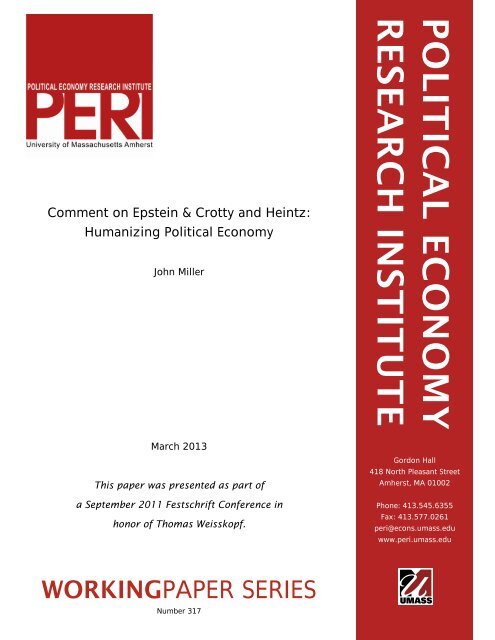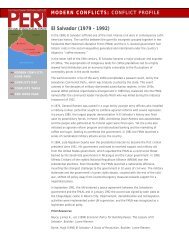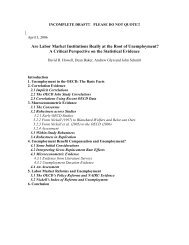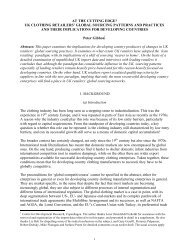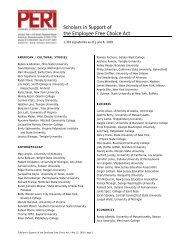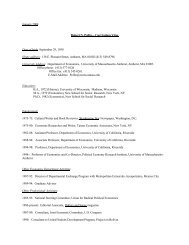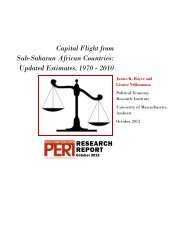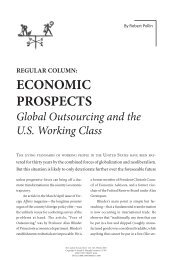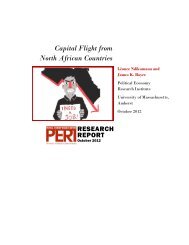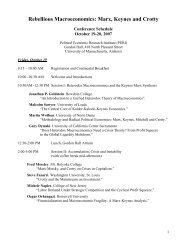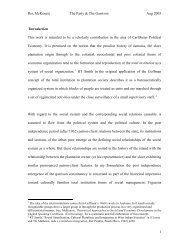Downloadfileadmin/pdf/working_papers/working_papers_301-350 ...
Downloadfileadmin/pdf/working_papers/working_papers_301-350 ...
Downloadfileadmin/pdf/working_papers/working_papers_301-350 ...
You also want an ePaper? Increase the reach of your titles
YUMPU automatically turns print PDFs into web optimized ePapers that Google loves.
Comment on Epstein & Crotty and Heintz:<br />
Humanizing Political Economy<br />
John Miller<br />
March 2013<br />
This paper was presented as part of<br />
a September 2011 Festschrift Conference in<br />
honor of Thomas Weisskopf.<br />
WORKINGPAPER SERIES<br />
Number 317<br />
RESEARCH INSTITUTE<br />
POLITICAL ECONOMY<br />
Gordon Hall<br />
418 North Pleasant Street<br />
Amherst, MA 01002<br />
Phone: 413.545.6355<br />
Fax: 413.577.0261<br />
peri@econs.umass.edu<br />
www.peri.umass.edu
PREFACE<br />
This <strong>working</strong> paper is one of a collection of <strong>papers</strong>, most of which were prepared for and presented at a festschrift<br />
conference to honor the life’s work of Professor Thomas Weisskopf of the University of Michigan,<br />
Ann Arbor. The conference took place on September 30 - October 1, 2011 at the Political Economy Research<br />
Institute, University of Massachusetts, Amherst. The full collection of <strong>papers</strong> will be published by Elgar<br />
Edward Publishing in February 2013 as a festschrift volume titled, Capitalism on Trial: Explorations in the<br />
Tradition of Thomas E. Weisskopf. The volume’s editors are Jeannette Wicks-Lim and Robert Pollin of PERI.<br />
Since the early 1970s, Tom Weisskopf has been challenging the foundations of mainstream economics and,<br />
still more fundamentally, the nature and logic of capitalism. That is, Weisskopf began putting capitalism on trial<br />
over 40 years ago. He rapidly established himself as a major contributor within the newly emerging field of<br />
radical economics and has remained a giant in the field ever since. The hallmarks of his work are his powerful<br />
commitments to both egalitarianism as a moral imperative and rigorous research standards as a means.<br />
We chose the themes and contributors for this <strong>working</strong> paper series, and the upcoming festschrift, to reflect<br />
the main areas of work on which Tom Weisskopf has focused, with the aim of extending research in these<br />
areas in productive new directions. The series is divided into eight sections, including closing reflections by<br />
our honoree himself, Professor Weisskopf. Each section except for the last includes comments by discussants<br />
as well as the <strong>papers</strong> themselves.<br />
The eight sections are as follows:<br />
1. Reflections on Thomas Weisskopf’s Contributions to Political Economy<br />
2. Issues in Developing Economies<br />
3. Power Dynamics in Capitalism<br />
4. Trends in U.S. Labor Markets<br />
5. Discrimination and the Role of Affirmative Action Policies<br />
6. Macroeconomic Issues in the United States<br />
7. Applications of Marxist Economic Theory<br />
8. Reflections by Thomas Weisskopf<br />
This <strong>working</strong> paper is 3 of 3 included in Section 6.<br />
MILLER / COMMENT ON EPSTEIN & CROTTY AND HEINTZ / PAGE 1<br />
- Jeannette Wicks-Lim and Robert Pollin
Comment on Epstein, Crotty and Heintz<br />
HUMANIZING POLITICAL ECONOMY<br />
When Charles Dickens launched his popular weekly, Household Words, he issued a plea for political economists<br />
to humanize their discipline. In his inaugural essay, Dickens wrote that, “Political economy is a mere skeleton<br />
unless it has a little human covering, and filling out, a little human bloom upon it, and a little human warmth<br />
in it.” 1 Humanizing political economy is surely a goal that we have all embraced. But few of us have contributed<br />
as much to reaching that goal and inspiring others to join in the effort to humanize political economy as<br />
Tom Weisskopf has.<br />
The two <strong>papers</strong> in this session take up important dynamics of the U.S. macroeconomy in the spirit of humanizing<br />
of political economy. In “How big is too big? What should investment banks do and how much should<br />
they be cut down to size?” Gerald Epstein and James Crotty ask how much of the activity of the U.S. financial<br />
sector is “socially useless,” and how to reduce the U.S. financial sector to a size that effectively serves the<br />
broader economy. In “Unpacking the U.S. Labor Share.” James Heintz examines the multitude of factors that<br />
determine labor’s share of the income generated by the U.S. economy.<br />
EPSTEIN AND CROTTY “HOW BIG IS TOO BIG?”<br />
This is an ambitious paper. Epstein and Crotty take up the multifaceted problem of determining the appropriate<br />
size of the financial system relative to services it provides to the “real economy,” and what of its activities<br />
are “not socially useful” That is a huge undertaking that required some intense data grubbing. But with<br />
the help of “well-designed descriptive statistics,” much like those Tom Weisskopf often used to great effect,<br />
Epstein and Crotty make some real progress in making the case for performing the sort of liposuction on the<br />
bloat of the financial sector we all would like to see happen.<br />
What counts as socially useless financial activity?<br />
Epstein and Crotty, of course, are far from the first to point out that the U.S. financial sector is “too big” and<br />
that much of what it is does is “socially useless.” But unlike the others, Epstein and Crotty measure how<br />
much of financial activity is not functionally inefficient – a pre-condition for determining what it would mean<br />
to cut the financial sector down the size.<br />
Epstein and Crotty have get at this question in two ways. They begin by describing how the ratio of the income<br />
extracted by the financial sector to the financing the sector provides to the real economy (measured by<br />
what they call “the financing gap”) rose dramatically beginning in the 1980s and reached its peak in the last<br />
decade (see Table 1).<br />
Then using what their micro-level data, Epstein and Crotty they estimate wasteful financial sector by examining<br />
activities of the five largest investment banks. Investment bank trading and trading related activity -- more<br />
or less their proprietary trading – serves as their first approximation of socially useless financial activity. That<br />
MILLER / COMMENT ON EPSTEIN & CROTTY AND HEINTZ / PAGE 2
trading typically neither makes markets nor provides hedges for customers. Not socially useful financial activity<br />
turns out to be a surprising large share of net revenues of those investment banks. In addition, they find<br />
that the losses on that proprietary trading, which constituted one half or more of the income of many of these<br />
banks just before the crash of 2007, were a main component of the losses that lead to the financial crisis<br />
and the financial bailout.<br />
But to what extent are Epstein’s and Crotty’s results peculiar to investment banks or the five large investment<br />
banks in their study? If data were available would similar results hold for smaller investment banks or the rest<br />
of the financial sector – for instance, for the large commercial banks that dominate derivatives trading?<br />
The answer to that question has important policy implications. For instance, should investment banks, or<br />
particular segments of the financial industry that are the locus of gambling, be the target of financial taxes<br />
such as transaction tax, or should those taxes by levied more widely across the financial sector.<br />
Socially destructive or socially useless?<br />
Epstein and Crotty also estimate that about one third of financial sector innovation is “motivated by tax, accounting,<br />
and/or regulatory, ‘arbitrage’ or ‘evasion’,” rather than “simple efficiency improvements.” But the<br />
authors believe that these figures underestimate the socially inefficient share of financial innovation because<br />
they do not capture the destructive impacts of innovations such as CDOs. In addition, as they point out, their<br />
own earlier research shows “in great detail the destructive nature of many of these innovations.”<br />
So how is that we are to regard the CDOs and CDSs that, as Epstein and Crotty say “helped to crash the system”<br />
and played such a key role pushing up the rate of income extraction enjoyed by the financial sector in<br />
recent decades.?<br />
Is the trading of these financial instruments social useless or socially destructive or both? And what exactly is<br />
the relationship between socially useless financial trading of investment banks and the socially destructive<br />
financial innovation?<br />
Consider for a minute collateralized debt obligations, CDOs, whose value is derived from the value of the<br />
mortgage based securities on which it based (which in turn derive their value from the value of the mortgages<br />
they contain). Is the buying and selling of these derivatives socially useless financial activity in the way Epstein<br />
and Crotty have defined the terms? Their first approximation suggests that CDOs are socially useless if they<br />
are part of the proprietary trading by an investment bank, but otherwise socially useful.<br />
But if CDOs (along with CDSs) “helped to crash the system” and are therefore socially destructive, does that<br />
obviate the need to sort through whether CDOs are their ilk are part of proprietary trading and therefore socially<br />
useless?<br />
Would it not be better to consider the vast array of derivatives spawned by financial innovation, including<br />
CDOs as transaction costs – the costs of buying and selling financial instruments, or as a public finance<br />
economist would put it, “the costs associated with exclusion?” 2 And compared with many other commodities<br />
are not the transaction costs associated with selling financial services unusually high? Take groceries for instance.<br />
The salaries of the checkout clerks, the cost of cash registrars, and the inconvenience of long lines are<br />
MILLER / COMMENT ON EPSTEIN & CROTTY AND HEINTZ / PAGE 3
all transaction costs associated with selling groceries. But no checkout clerk gets paid what the buyers and<br />
sellers of securities do. And no checkout clerk ever contributed a financial crisis like that of 2008. And if the<br />
level of waste and destruction that Epstein and Crotty report is endemic to the buying and selling of financial<br />
instruments, then doesn’t the public finance prescription for commodities with prohibitively high transactions<br />
costs apply: provide those commodities through the public sector?<br />
HEINTZ: UNPACKING OF THE U.S. LABOR SHARE<br />
Heintz’s paper responds to “Marxian Crisis Theory and the Rate of Profit in the Postwar U.S. Economy,” 3<br />
Weisskopf’s classic article. Beyond that, Heintz manages to reproduce much of what was so influential about<br />
the Weisskopf article: its sharp insights rendered highly accessible through an extreme clarity.<br />
In his article, Weisskopf examined the impact of three ratios on the U.S. rate of profit from 1949 to 1975.<br />
Each ratio is drawn from a different strand of Marxist crisis theory, the rising organic composition of capital,<br />
a realization failure, and the rising strength of labor. The labor share, which Heintz unpacks in his excellent<br />
paper, is meant to be both a barometer of the strength of labor and labor’s ability to squeeze profits.<br />
Heintz concentrates on Weisskopf’s finding that workers were able to push up their wage share by defending<br />
their position through improving terms of trade with the capitalist class and in that way squeeze profits in the<br />
period from the mid 1960s to the mid 1970s. There is nothing arbitrary about Heintz’s emphasis. He has<br />
tackled what Weisskopf called “the most interesting of the empirical results” of his paper. Weisskopf summarized<br />
those results as follows:<br />
“The long-term decline in the rate of profit from 1949 to 1975 was almost entirely attributable<br />
to a rise in the true share of wages, which indicates a rise in the strength of labour. This<br />
rise, however, was largely defensive in nature. The <strong>working</strong> class did not succeed in making<br />
true real wage gains commensurate with the growth of true productivity; it merely succeeded<br />
in defending itself somewhat more successfully against a long-term deterioration in the terms<br />
of trade than did the capitalist class.” 4<br />
I had two questions about Heintz’s unpacking of the U.S. labor share, and a comment about his paper.<br />
Heintz and Weisskopf on the defensive strength of labor<br />
My first question is about Heintz’s finding that “the defensive strength of labor … has evaporated.” Heinz<br />
points out that the “relative rates of change of prices indices [the CPI-U and PCE prices indices] would have<br />
contributed to a decline the real labor share relative to the nominal labor share.” He adds that “the decline<br />
attributable to price movements would be most pronounced beginning in the 1980s.”<br />
But to what extent do Heintz’s results differ from the results in the Weisskopf paper for the years their studies<br />
overlap, from 1960 to 1975? And are the differences attributable to the choice of price indices or other<br />
factors strong enough to suggest that Weisskopf’s finding that the defensive strength of labor lies behind the<br />
fall in the profit rate from the mid-1960s to mid-1970s does not hold and labor’s defensive strength was already<br />
on the wane by then?<br />
MILLER / COMMENT ON EPSTEIN & CROTTY AND HEINTZ / PAGE 4
Changing capitalism and the real labor share<br />
One of the most impressive things about “Unpacking the U.S. Labor Share,” is how Heintz incorporates the<br />
changing contours of U.S. capitalism into his analysis of the real labor share. Two of those trends are especially<br />
worth mentioning:<br />
First, Heintz finds that the growing internationalization of production and increased imports of consumer<br />
goods, specifically manufactured goods, into the United States were not driving the reduction in labor's terms<br />
of trade. The prices of consumer durables and certain categories of non-durable goods, e.g. clothing, actual<br />
decreased over the time period from 1991 to 2009. On the other hand, several categories of goods and services<br />
did show above average price increases over this period - housing, gasoline, medical care, financial services.<br />
Heintz attributes those rising relative prices to “pressure from economic rents.” Those rents reduced<br />
the real income of <strong>working</strong> people but “did not squeeze profits.”<br />
Second, the dramatically worsening inequality of the last few decades, especially among wage workers,<br />
prompts Heintz to turn to the real labor share of production workers to gauge the strength of workers. Incorporating<br />
the rising inequality into any analysis of the real labor share is crucial at this moment. Despite a<br />
rising average income in the years before the crisis, most people experienced a virtual stagnation in their income<br />
and relied more and more heavily on credit to meet their needs<br />
How to assess the strength of in an era of extreme inequality?<br />
That brings me to my other question. Just how much does rising inequality alter Heintz’s analysis of the aggregate<br />
real labor share. In the current period, how useful is the aggregate labor share as a gauge of the<br />
strength of labor, either it offensive or defensive strength? Does the aggregate real labor share explain the<br />
declining strength of labor in today’s economy as well as the aggregate real labor share captured the rising<br />
strength of labor and its squeeze on the profit rate in the period from the mid-1960s to the mid-1970s?<br />
Or should we concentrate on the labor share of production workers, as Heintz seems to suggest at some<br />
points, as the appropriate gauge of labor’s strength and labor its impact on profitability?<br />
RESTORING FINANCIAL STABILITY AND THE LABOR SHARE<br />
The Epstein and Crotty paper and the Heintz paper both expose the failure of the U.S. economy to serve<br />
humanity. One estimates just how much of financial sector activity is socially useless and in some cases socially<br />
destructive. The other unpacks the trends that have left an ever smaller a proportion of national income<br />
devoted to the real labor share, especially of production workers.<br />
Cutting down the financial sector to its functional size would help open up the space for the real labor share<br />
to rise again at the expense of profits and the rents extracted by the financial sector. That would mean restoring<br />
macroeconomic conditions more like those of that prevailed between mid-1960s and mid-1970s when<br />
financial regulation was more extensive, financial crisis were less frequent and, the real labor share was far<br />
greater than today.<br />
MILLER / COMMENT ON EPSTEIN & CROTTY AND HEINTZ / PAGE 5
1 As quoted by Sylvia Nasar in Grand Pursuit: The Story of Economic Genius (New York: Simon & Schuster, 2011), p. 10.<br />
2 Joseph E. Stiglitz, Economics of the Public Sector, Third Edition (New York: W.W. Norton and Company, 2000), p. 135.<br />
3 Thomas E. Weisskopf, “Marxian crisis theory and the rate of profit in the postwar U.S. economy,” Cambridge Journal of Economics,<br />
1979, 3, 341-378.<br />
4 Ibid, p. 370.<br />
MILLER / COMMENT ON EPSTEIN & CROTTY AND HEINTZ / PAGE 6


